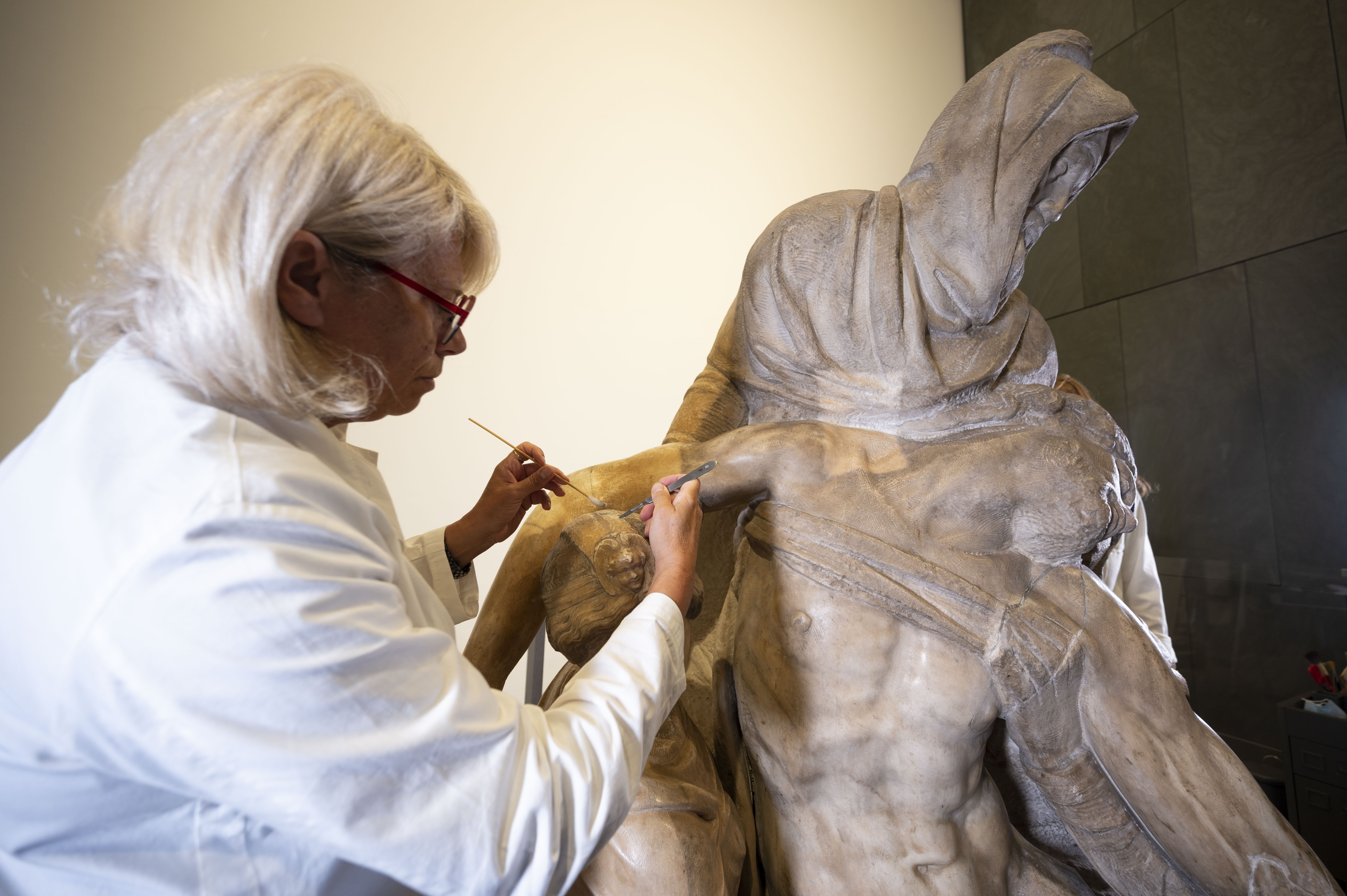
New restoration work is helping art historians understand Michelangelo’s Bandini Pietà, one of the Renaissance master’s great unfinished sculptures. A preliminary cleaning has already revealed previously unknown details, such as different tool marks marks made by the artist and remnants of the plaster used to make a cast of the work in the 19th century.
The restoration, which began last November but was interrupted by the global shutdown, is the “first important and in-depth restoration in the entire history of this work in more four centuries of life,” Timothy Verdon, director of the Museo dell’Opera del Duomo in Florence, where the sculpture has been held since 1981, said in video released by the museum.
Michelangelo intended to use the sculpture as his own tomb marker. “He carved it thinking of it as a testimonial to his art and to his faith,” Verdon said, noting that the restoration provides “an extraordinary occasion to evaluate this most personal work by Michelangelo.”
Shaped from a single block of white Carrara marble, the Bandini Pietà is the third and final pieta that Michelangelo worked on during his career.
Restoration of Michelangelo’s Bandini Pietà at the Museo dell’Opera del Duomo in Florence. Photo by Claudio Giovannini/CGE, courtesy of the Opera di Santa Maria del Fiore.
“It’s the last of the great Michelangelo statues,” Verdon said.
Unlike the more famous Vatican composition and the later Rondanini Pietà, the Bandini Pietà does not just depict the Virgin Mary cradling the body of her son Jesus. She is supported in her grief by the figures of Mary Magdalene and the elderly Nicodemus, here doubling as a self-portrait of Michelangelo in his old age.
The elderly artist worked on the piece from 1547 to 1555, but ultimately abandoned it. According to the early art historian Giorgio Vasari, there were imperfections in the marble, but Michelangelo also might have run into issues with the composition, including where to place Christ’s left leg, which he never carved.
“In a fit of rage,” Verdon said, “he tried to destroy it.” Michelangelo swung the hammer he’d been using to chisel the marble and started hacking at it. “One can still see very clearly the signs of breakage in Christ’s left arm and other parts of the statue.” Fortunately for art history, the artist gave the work to a servant who had it repaired.
Restoration of Michelangelo’s Bandini Pietà at the Museo dell’Opera del Duomo in Florence. Photo by Claudio Giovannini/CGE, courtesy of the Opera di Santa Maria del Fiore.
Now, diagnostic studies by the restorers are allowing the experts to learn more about what the work would have originally looked like, before it was discolored by more than 470 years of accumulated dust and wax. The restorers began their work on the back of the sculpture, which had the most wax deposits, likely from candles on the main altar in the Florence Duomo, the Santa Maria del Fiore, where it was displayed for 220 years. (The 19th-century copy is at Florence’s Gipsoteca of the Liceo Artistico di Porta Romana.)
The team developed a non-invasive cleaning method using cotton swabs soaked with lukewarm deionized water. Where the buildup on the surface is the greatest, the restorers have opted for the careful use of scalpels. Midway through the cleaning, the contrast in color between the cleaned and untreated surfaces quite dramatic.
Paola Rosa, a 30-year restoration veteran, is heading the project along with the museum’s in-house conservators and Annamaria Giusti, former director of the stone and marble restoration department of Florence’s Opificio delle Pietre Dure, the Italian state conservation school.
Restoration of Michelangelo’s Bandini Pietà at the Museo dell’Opera del Duomo in Florence. Photo by Claudio Giovannini/CGE, courtesy of the Opera di Santa Maria del Fiore.
The museum has constructed a platform around the work during the restoration, which is being funded by the Friends of Florence Foundation. Beginning September 28, visitors will be allowed onto the worksite in guided tours. Groups of five visitors will meet with the restorers and Opera di Santa Maria del Fiore experts to learn more about the project, which is expected to be complete by the end of the year.
“We believe among many kinds of information that are already emerging from the restoration, there may also come the indications for a new narration a new way of telling the story of this extraordinary work,” Verdon said.
The end result, he added, will be the ability to appreciate the statue anew, “with a luminosity in the marble and a clean and uncompromised presentation of the surface values such as has not been seen for centuries.”
See more photos of the restoration work below.
Restoration of Michelangelo’s Bandini Pietà at the Museo dell’Opera del Duomo in Florence. Photo by Claudio Giovannini/CGE, courtesy of the Opera di Santa Maria del Fiore.
Restoration of Michelangelo’s Bandini Pietà at the Museo dell’Opera del Duomo in Florence. Photo by Claudio Giovannini/CGE, courtesy of the Opera di Santa Maria del Fiore.
Restoration of Michelangelo’s Bandini Pietà at the Museo dell’Opera del Duomo in Florence. Photo by Claudio Giovannini/CGE, courtesy of the Opera di Santa Maria del Fiore.
Restoration of Michelangelo’s Bandini Pietà at the Museo dell’Opera del Duomo in Florence. Photo by Claudio Giovannini/CGE, courtesy of the Opera di Santa Maria del Fiore.